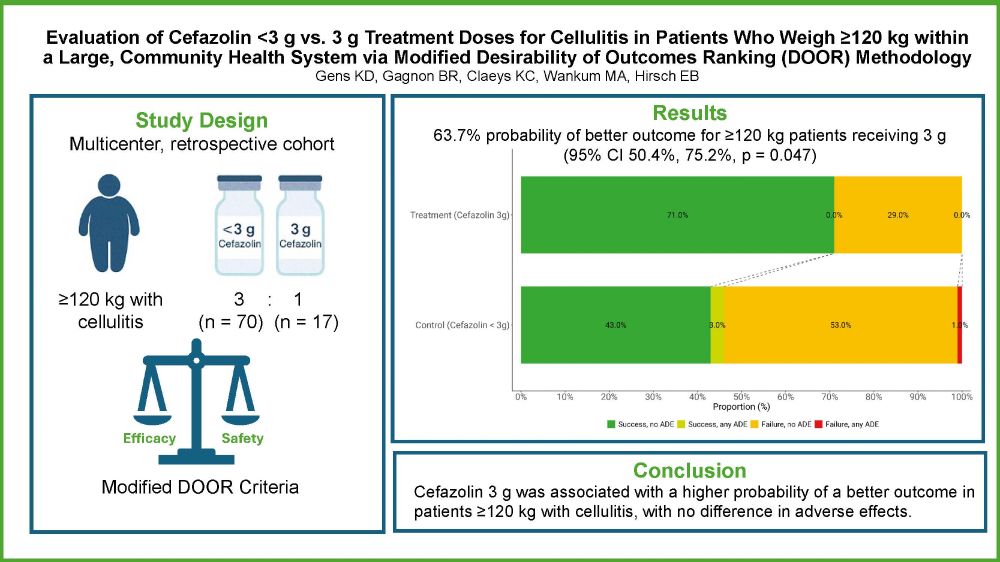
Our host Dr, Ryan Moenster is back and breaking down the recently published ATS pneumonia guidelines — what’s pneu and what it means for your antimicrobial game! Dr Hartlage is back to join the conversation, plus fresh takes from Dr. Weissma and Angelo.
🎧 sidp.pinecast.co

Our host Dr, Ryan Moenster is back and breaking down the recently published ATS pneumonia guidelines — what’s pneu and what it means for your antimicrobial game! Dr Hartlage is back to join the conversation, plus fresh takes from Dr. Weissma and Angelo.
🎧 sidp.pinecast.co
Annie Joseph & Angela Huttner host Dan Morgan (USA) & Valerie Vaughn (USA) to discuss diagnostic stewardship - what it means and why we should do it.
#IDSky #clinmicro #MedSky #meded

Annie Joseph & Angela Huttner host Dan Morgan (USA) & Valerie Vaughn (USA) to discuss diagnostic stewardship - what it means and why we should do it.
#IDSky #clinmicro #MedSky #meded
https://ow.ly/HZao50XwVYg
#IDSky #clinmicro

https://ow.ly/HZao50XwVYg
#IDSky #clinmicro
Over a 10 yr period, 6.6% of Flu cases, 12.2% of RSV cases, and 10.9% of PIV cases were Hosp-Acquired. Most in ICH.
onlinelibrary.wiley.com/doi/10.1111/...

Over a 10 yr period, 6.6% of Flu cases, 12.2% of RSV cases, and 10.9% of PIV cases were Hosp-Acquired. Most in ICH.
onlinelibrary.wiley.com/doi/10.1111/...
Sure -- plenty of great advances!
Here are a half-dozen to celebrate (and be grateful for) in 2025, believe it or not. #idsky
blogs.jwatch.org/hiv-id-obser...

Sure -- plenty of great advances!
Here are a half-dozen to celebrate (and be grateful for) in 2025, believe it or not. #idsky
blogs.jwatch.org/hiv-id-obser...
Transcript: bit.ly/4887CZq

Transcript: bit.ly/4887CZq

bit.ly/4rfM8CG

bit.ly/4rfM8CG
paulsaxmd.substack.com/p/three-myth...

paulsaxmd.substack.com/p/three-myth...
open.substack.com/pub/pauloffi...

open.substack.com/pub/pauloffi...
Our statement w/ @hivma.bsky.social, APIC, @sheaepi.bsky.social & @sidpharm.bsky.social: bit.ly/3XEc0KH

Our statement w/ @hivma.bsky.social, APIC, @sheaepi.bsky.social & @sidpharm.bsky.social: bit.ly/3XEc0KH
www.nejm.org/doi/full/10....

www.nejm.org/doi/full/10....
mRNA vaccine with increased local and systemic reactions, AEs similar… #IDSky #vaccines
www.nejm.org/doi/full/10....

mRNA vaccine with increased local and systemic reactions, AEs similar… #IDSky #vaccines
www.nejm.org/doi/full/10....
🔗 [link] #idsky
www.amjmed.com/article/S000...

🔗 [link] #idsky
www.amjmed.com/article/S000...
Play Infectious Connections today: connections.firstline.org
Discover the engaging educational content crafted by Shaqil Peermohamed, MD! #IDSky #PharmSky #AMSSKy

- Yersinia pestis
- Vibrio parahemolyticus
- Burkholderia mallei and pseudomallei
- Haemophilus ducreyi
- Klebsiella granulomatis
#IDSky

- Yersinia pestis
- Vibrio parahemolyticus
- Burkholderia mallei and pseudomallei
- Haemophilus ducreyi
- Klebsiella granulomatis
#IDSky
🔍 What were we seeing? 3 g of cefazolin for cellulitis in obese patients.
🚪 Why DOOR? It combines efficacy and safety outcomes.
💡 What did we find? 3 g might be a good idea.
lnkd.in/gbP4sx_7
@ebhirsch.bsky.social

🔍 What were we seeing? 3 g of cefazolin for cellulitis in obese patients.
🚪 Why DOOR? It combines efficacy and safety outcomes.
💡 What did we find? 3 g might be a good idea.
lnkd.in/gbP4sx_7
@ebhirsch.bsky.social
“English people called it the
“Spanish disease”… the Spanish called it mal inglés.
The Dutch called it “Spanish smallpox”
The Russians blamed the Poles, and the Turks referred to it as the “Christian disease””
#IDSky
academic.oup.com/jid/advance-...

“English people called it the
“Spanish disease”… the Spanish called it mal inglés.
The Dutch called it “Spanish smallpox”
The Russians blamed the Poles, and the Turks referred to it as the “Christian disease””
#IDSky
academic.oup.com/jid/advance-...
More:
www.unmc.edu/newsroom/202...

More:
www.unmc.edu/newsroom/202...
AI + WGS can speed outbreak reviews and help IP teams act faster #IDSky
Genomic surveillance is a key must!
📃: doi.org/10.1017/ice....




AI + WGS can speed outbreak reviews and help IP teams act faster #IDSky
Genomic surveillance is a key must!
📃: doi.org/10.1017/ice....


